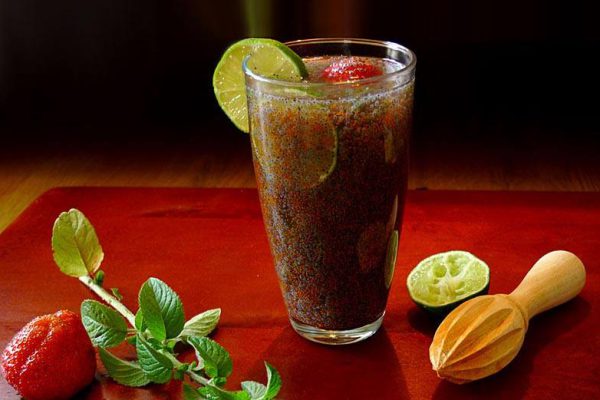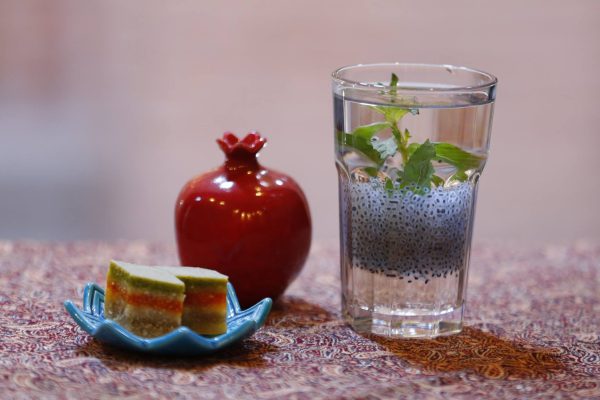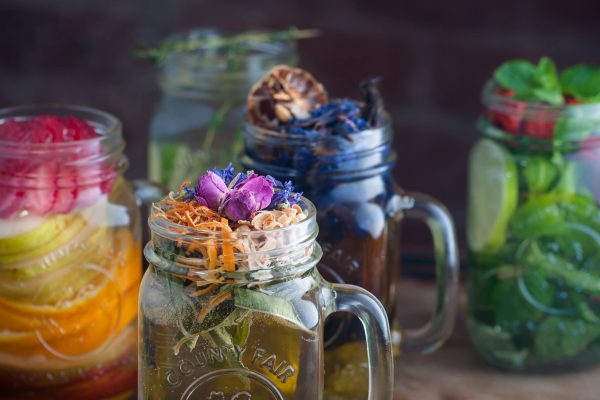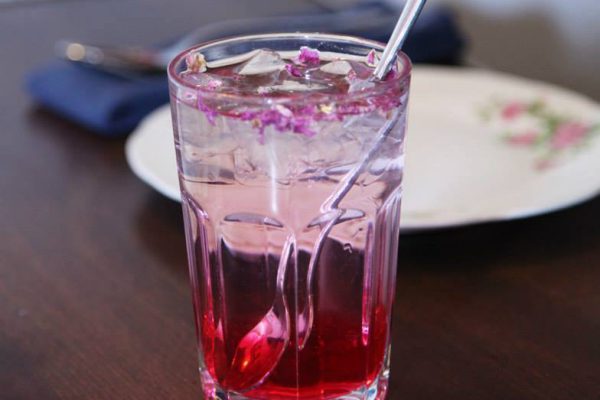Sharbat is a popular drink in Western and Southern Asia. It is typically prepared from fruits, herbs as well as flower petals.
The word sharbat comes from Persian (sharbat), and sherbet comes from Turkish şerbet. Both words actually come from Arabic (sharba) which means “a drink”, and (shariba), “to drink”.
Sherbet entered the English language as sorbet, which is now more of an iced dessert or palate cleanser than a drink.
This beverage is very common in iran but also in India, Azerbaijan ,Turkey, Afghanistan, Pakistan, Bangladesh as well as many Arab countries. It is often consumed by Muslims when breaking their fast, during the month of Ramadan, which happens to start this coming week. Also, because of the Islamic ban on alcohol, beverages in the Islamic world have mostly consisted of fruit juices and syrups.
The first mentions of sharbat date from the 12th century. In the Persian book Zakhireye Khwarazmshahi, royal Islamic physician Ismail Gorgani describes different types of sharbats in Iran, including ghooreh (sour grape), anar (pomegranate) and sekanjebin (mint).
Babur, the first Mughal Emperor, popularized the drink in the Indian subcontinent in the sixteenth century. He used to ask for frequent loads of ice to be sent from the Himalayas to make cool refreshing drinks. This is the same ice that was used to make other iced delicacies such as kulfi. Badam ka sharbat, for example, is now a famous Indian sharbat with almond. Other popular flavors include gulab sharbat (rose sharbat), amla sharbat (gooseberry sharbat), kokam sharbat, bel sharbat (wood apple sharbat) or kachi keri sharbat (raw mango sharbat).
At the same time and in the centuries that followed, spices and fruits were grown at the Ottoman Palace of Topkapi in Istanbul to be used in sharbat. One of the earliest mentions of Turkish sherbet was by the French botanist Pierre Belon, who traveled to Turkey, Egypt, the Holy Land and Persia between 1546 and 1551.
References to sherbet start to appear in English sources in the seventeenth century. English Philosopher and Scientist Sir Francis Bacon was actually one of the first to write about this novelty in 1627.
The fashion for Turkish sherbet in Europe started in Venice in the seventeenth century, and from there, it spread to the rest of Italy. Turkish word ‘şerbet’ actually entered the Italian language as sorbetto during the period of Ottoman-Byzantine-Venetian relations.
The colors of all these sharbats actually reminded me of granita, another Italian iced delicacy that Vera prepared last summer.
The reason that sherbet became so widely popular was simply that, until the early twentieth century, there were very few ways to preserve and transport fresh fruits. Because of this, fruits remained seasonal and local, except when they could be either dried or reduced to syrup, which are two forms that served as sharbat extract.
Give me a sun, I care not how hot, and sherbet, I care not how cool, and my Heaven is as easily made as your Persian’s. — Lord Byron during his visit to Istanbul in 1813
In the collection of Middle Eastern and South Asian stories The Thousand and One Nights, sherbet also appears as a refreshing and medicinal drink.
Sherbet is a very traditional drink in iran . It is made with everything from fruits like pomegranate, apricot, quince, orange, or cherry, but also from rose petals, basil, mint, saffron or seeds like cardamom, caraway, coriander.
Iranian summer beverage and drinks
Sharbat e Khakshir – (Sisymbrium irio, known as London Rocket ) Persian Refreshing Summer Drink
There is another popular traditional drink that can be used in the summer time against the heat and dehydration and it also can be used as thirst quencher during the hot summer days it can be enjoyed all through the year as a delicious soothing drink with many health benefits. This Syrup can be served to your guests on a hot summer day with ice cube and lightly sweetened cold water with a touch of rose water. The tiniest reddish brown seeds of Khakshir sit at the bottom of the glass which for drinking the syrup, stirring up is recommended. Stir and watch the beautiful dance of Khakshir seeds in the water, take a sip and repeat. Khakshir is also a natural and herbal liver detox drink; it is also known as the skin improvement and can be used for healing the wound, fever reducer and many other benefits. Khakshir drink can also be used as medicinal purposes without adding any sugar or ice cubes all year around. The scientific name of Khakshir is Sisymbrium irio and is known as London rocket.

Sekanjabin: A Sweet and Sour Ancient Persian Syrup and Drink
Sekanjabin is one of the oldest sweet and sour syrups in Iran, dating back to the ancient times. It’s a combination of vinegar (serkeh) and “angebin,” which refers to honey and the natural honey sweet. Sekanjabin and its drink (sharbat-e Sekanjabin) are usually served during the summer. Mostly used in the southern cities of Iran where the summer is are long and hot! Having Sekanjabin syrup with romaine lettuce was an afternoon ritual in our home. Sekanjabin is not just syrup but it also has medicinal values with healing powers and a good source of vitamins.

Persian Saffron (Zafaran) sharbat
Saffron or zafaran comes from Persian word ‘ Zarparan’ meaning flower with golden petal. Saffron is one of essential spices in Iranian baking and cooking. This lovely spice is used in dishes such as different stews or rice dishes. Saffron is known as king of spices. (a mix of rose water and saffron), Tokhm Sharbati (chia seeds) and Khak Shir (descurainia). Iranian traditional medicine is based on the idea that everything in the world, from objects to human body, has warm or cold nature. That’s why distillates and sharbats are not just refreshments, they are remedies.

Persian Rosewater Chia Seed sharbat

